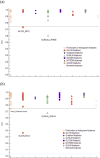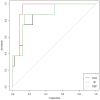Deep learning-based reconstruction on cardiac CT yields distinct radiomic features compared to iterative and filtered back projection reconstructions
- PMID: 36071138
- PMCID: PMC9452656
- DOI: 10.1038/s41598-022-19546-1
Deep learning-based reconstruction on cardiac CT yields distinct radiomic features compared to iterative and filtered back projection reconstructions
Abstract
We aimed to determine the effects of deep learning-based reconstruction (DLR) on radiomic features obtained from cardiac computed tomography (CT) by comparing with iterative reconstruction (IR), and filtered back projection (FBP). A total of 284 consecutive patients with 285 cardiac CT scans that were reconstructed with DLR, IR, and FBP, were retrospectively enrolled. Radiomic features were extracted from the left ventricular (LV) myocardium, and from the periprosthetic mass if patients had cardiac valve replacement. Radiomic features of LV myocardium from each reconstruction were compared using a fitting linear mixed model. Radiomics models were developed to diagnose periprosthetic abnormality, and the performance was evaluated using the area under the receiver characteristics curve (AUC). Most radiomic features of LV myocardium (73 of 88) were significantly different in pairwise comparisons between all three reconstruction methods (P < 0.05). The radiomics model on IR exhibited the best diagnostic performance (AUC 0.948, 95% CI 0.880-1), relative to DLR (AUC 0.873, 95% CI 0.735-1) and FBP (AUC 0.875, 95% CI 0.731-1), but these differences did not reach significance (P > 0.05). In conclusion, applying DLR to cardiac CT scans yields radiomic features distinct from those obtained with IR and FBP, implying that feature robustness is not guaranteed when applying DLR.
© 2022. The Author(s).
Conflict of interest statement
The authors declare no competing interests.
Figures





Similar articles
-
Low-contrast lesion detection in neck CT: a multireader study comparing deep learning, iterative, and filtered back projection reconstructions using realistic phantoms.Eur Radiol Exp. 2024 Jul 24;8(1):84. doi: 10.1186/s41747-024-00486-6. Eur Radiol Exp. 2024. PMID: 39046565 Free PMC article.
-
Superior objective and subjective image quality of deep learning reconstruction for low-dose abdominal CT imaging in comparison with model-based iterative reconstruction and filtered back projection.Br J Radiol. 2021 Jul 1;94(1123):20201357. doi: 10.1259/bjr.20201357. Br J Radiol. 2021. PMID: 34142867 Free PMC article.
-
The impact of deep learning reconstruction on image quality and coronary CT angiography-derived fractional flow reserve values.Eur Radiol. 2022 Nov;32(11):7918-7926. doi: 10.1007/s00330-022-08796-2. Epub 2022 May 21. Eur Radiol. 2022. PMID: 35596780
-
Comparison of a Deep Learning-Based Reconstruction Algorithm with Filtered Back Projection and Iterative Reconstruction Algorithms for Pediatric Abdominopelvic CT.Korean J Radiol. 2022 Jul;23(7):752-762. doi: 10.3348/kjr.2021.0466. Epub 2022 May 27. Korean J Radiol. 2022. PMID: 35695313 Free PMC article.
-
Quantitative analysis of emphysema and airway measurements according to iterative reconstruction algorithms: comparison of filtered back projection, adaptive statistical iterative reconstruction and model-based iterative reconstruction.Eur Radiol. 2014 Apr;24(4):799-806. doi: 10.1007/s00330-013-3078-5. Epub 2013 Nov 26. Eur Radiol. 2014. PMID: 24275806 Review.
Cited by
-
Impact of deep learning image reconstruction algorithms on CT radiomic features in patients with liver tumors.Front Oncol. 2023 Apr 5;13:1167745. doi: 10.3389/fonc.2023.1167745. eCollection 2023. Front Oncol. 2023. PMID: 37091167 Free PMC article.
-
Impact of Emerging Deep Learning-Based MR Image Reconstruction Algorithms on Abdominal MRI Radiomic Features.J Comput Assist Tomogr. 2024 Nov-Dec 01;48(6):955-962. doi: 10.1097/RCT.0000000000001648. Epub 2024 Aug 22. J Comput Assist Tomogr. 2024. PMID: 39190703 Free PMC article.
References
-
- Taylor AJ, et al. ACCF/SCCT/ACR/AHA/ASE/ASNC/NASCI/SCAI/SCMR 2010 appropriate use criteria for cardiac computed tomography: A report of the American College of Cardiology Foundation Appropriate Use Criteria Task Force, the Society of Cardiovascular Computed Tomography, the American College of Radiology, the American Heart Association, the American Society of Echocardiography, the American Society of Nuclear Cardiology, the North American Society for Cardiovascular Imaging, the Society for Cardiovascular Angiography and Interventions, and the Society for Cardiovascular Magnetic Resonance. J. Am. Coll. Cardiol. 2010;56:1864–1894. doi: 10.1016/j.jacc.2010.07.005. - DOI - PubMed
-
- Doherty JU, Kort S, Mehran R, Schoenhagen P, Soman P. ACC/AATS/AHA/ASE/ASNC/HRS/SCAI/SCCT/SCMR/STS 2017 appropriate use criteria for multimodality imaging in valvular heart disease: A report of the American College of Cardiology Appropriate Use Criteria Task Force, American Association for Thoracic Surgery, American Heart Association, American Society of Echocardiography, American Society of Nuclear Cardiology, Heart Rhythm Society, Society for Cardiovascular Angiography and Interventions, Society of Cardiovascular Computed Tomography, Society for Cardiovascular Magnetic Resonance, and Society of Thoracic Surgeons. J. Am. Coll. Cardiol. 2017;70:1647–1672. doi: 10.1016/j.jacc.2017.07.732. - DOI - PubMed
Publication types
MeSH terms
LinkOut - more resources
Full Text Sources
Miscellaneous

